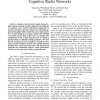Free Online Productivity Tools
i2Speak
i2Symbol
i2OCR
iTex2Img
iWeb2Print
iWeb2Shot
i2Type
iPdf2Split
iPdf2Merge
i2Bopomofo
i2Arabic
i2Style
i2Image
i2PDF
iLatex2Rtf
Sci2ools
GLOBECOM
2010
IEEE
2010
IEEE
Joint Optimization of Spectrum Sensing for Cognitive Radio Networks
Abstract--Cognitive radio networks require fast and reliable spectrum sensing to achieve high network utilization by secondary users. Current optimization approaches to spectrum sensing to-date have focussed on maximizing aggregate throughput while considering only a single parameter variable pertinent to sensing, notably the threshold or duration, but not both. In this work, we consider joint minimization of the average detection time for finding a spectrum hole as a function of both parameters. We show that the resulting non-convex problem is actually biconvex under practical conditions and solve for a global optimum detection time. Numerical results show that the proposed approach can considerably improve system performance in terms of the mean time to detect a spectrum hole.
| Added | 11 Feb 2011 |
| Updated | 11 Feb 2011 |
| Type | Journal |
| Year | 2010 |
| Where | GLOBECOM |
| Authors | Ling Luo, Chittabrata Ghosh, Sumit Roy |
Comments (0)

